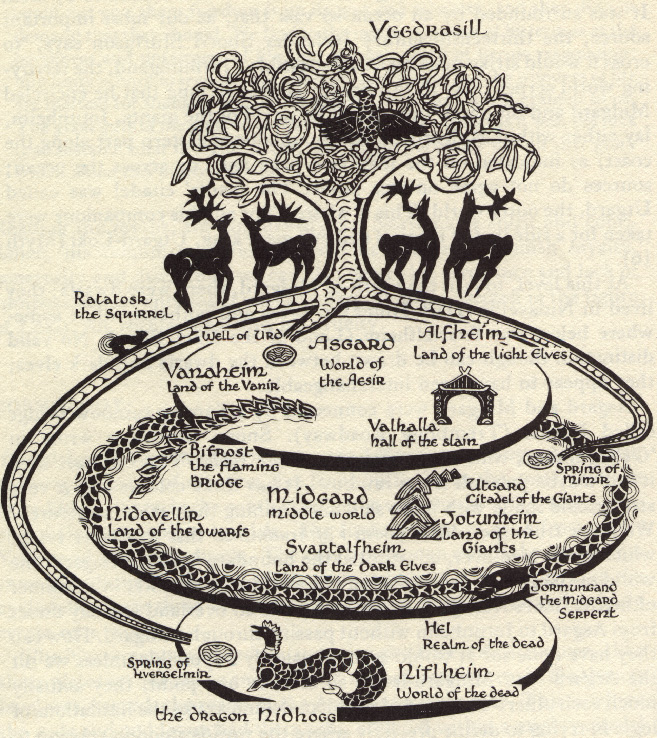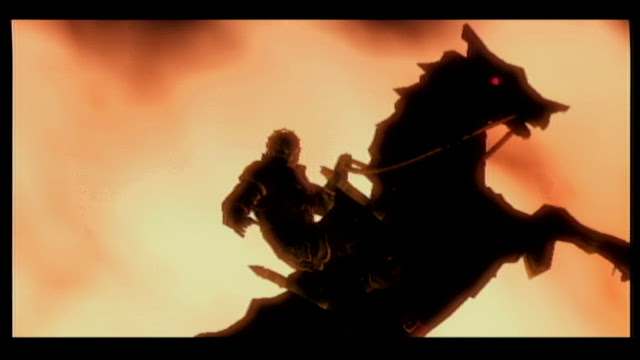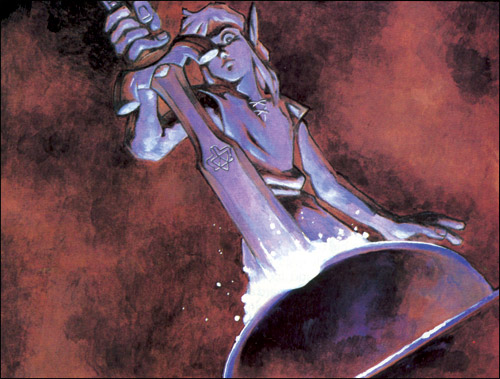The Hyrulian Pantheon: Hyrulean Cosmology
Posted on May 07 2012 by Mases Hagopian
 No study of cultural mythology can proceed without an understanding of how that culture perceives their world. Cosmology itself isn’t restricted to mythologies. The Big Bang Theory is a cosmological theory, for example. Cosmologists seek to understand the origin, evolution, and structure of the universe, as well as what keeps it all together, and what the ultimate fate of the universe is.
No study of cultural mythology can proceed without an understanding of how that culture perceives their world. Cosmology itself isn’t restricted to mythologies. The Big Bang Theory is a cosmological theory, for example. Cosmologists seek to understand the origin, evolution, and structure of the universe, as well as what keeps it all together, and what the ultimate fate of the universe is.
Greek cosmology is relatively simple, once you figure out which version of it you’re going to go with. The most popular is Homer’s depiction. Picture the world as a flat disc. This disc is comprised of the Mediterranean Sea, the surrounding countries, and water until the edge of the disc. Above it, picture the sky as a dome. Below it, picture the underworld as an upside-down dome. Humans live on the earth, the middle disc. The gods live in the sky in the upper dome. People go to the lower dome when they die, and some gods and creatures live there too. Everything is connected by Mount Olympus. You can ascend to the home of the gods by climbing Mount Olympus. To get to the underworld you need to descend through tunnels. I would imagine that the tunnels were located near Mount Olympus, as it was the center of the Greek world. Therefore, when Greek myths say that the gods came down they literally mean that they descended from their dome in the sky to the earth disc.
Norse cosmology is not so simple, but is more like Hyrulean cosmology. In the Norse myths there are nine worlds. The top of the universe is in the direction we refer to as south, and the bottom of the universe is in the direction we refer to as north. They descend, from top (south) to bottom (north) as follows:
The three worlds above the earth, in heaven:
- Múspellsheimr (Muspelheim or Muspell) (Fire, in the south)
- Álfheimr (Alfheim) (Home of the Light Elves)
- Ásgarðr (Asgard) (Home of the Vanir—a class of gods)
The three worlds on earth:
- Vanaheimr (Vanaheim) (Home of the Asir, and location of Odin’s feasthall)
- Miðgarðr (Midgard) (Humans—Our home)
- Jötunheimr (Jotunheim) (Home of the giants, very evil)
The three worlds below the earth, in underworld:
- Svartálfaheimr (Svartalfheim) (Home of the Dark Elves, aka dwarves)
- Niflhel (Hel) (Norse Underworld)
- Niflheimr (Niflheim) (Ice, in the north)
First, it’s interesting that the world is structured upside down. Second, it’s interesting that each level of the world is comprised of three tiers, and each tier is home to something different. Most of the Norse gods, including the leader of the gods Odin, actually live on earth in the upper plane. This is very reminiscent of Zelda, where the minor deities are pictured to be walking (swimming/flying/etc) among them.
Something to note is that in the same way that Mount Olympus connects the three Greek worlds, a large tree named Yggdrasill connects the Norse worlds.
(Source: Wikipedia)
Okay, interesting, but how does this relate to Zelda? A Link to the Past’s legends were useful for more reasons than one. Through them we discover Hyruleans’ understanding of their world. In the creation story, it is said that the Three Golden Goddesses came from a distant nebula and created the world. When their labor was done, they left the world and the Triforce was left in the place where they exited the world. They presumably returned to the distant nebula they came from. The place where the Triforce rested became the Sacred Realm because of the holy nature of the divine relic. Ocarina of Time merely calls this “another world” but the understanding that they came from somewhere else is still present in the myth.
Right now, we can see the top two worlds: the distant nebula where the goddesses are said to come from and return to, and the sacred realm where the Triforce exists.
I would say that the Hyrulean world is built mostly sideways. Right to left or left to right doesn’t really matter it seems. Many of the levels of the world seem to exists parallel to each other, but not in the same space, although some do go down or up a little. So far, Hyrulean cosmology would be mapped like this:
Labrynia and Holodrum also exist in the same world as Hyrule, just across the sea. They are different continents, not different dimensions. New Hyrule also exists as another continent.
After Ocarina of Time, Link goes on a personal journey, where he finds himself falling down through a portal in a tree. He winds up in a different world, the world of Termina. It is a parallel world, with twisted, irreverent references to the goddesses, but not the same world necessarily. I believe that the world of Termina is very close to the Hyrule, but not the same.
The map then looks like this:
Koholint was a dream of the Windfish, and therefore doesn’t count as an actual place within the universe. The world of the Ocean King from Phantom Hourglass is a similar illusion.
From there, we have to dig into the ending events of A Link to the Past, Ocarina of Time, and Spirit Tracks. In A Link to the Past, we are led to think that the Dark World that we have entered used to be the Sacred Realm, but was poisoned by Ganondorf’s evil. Ocarina of Time details that poisoning, saying that Ganondorf poisoned the Sacred Realm when he entered it and stole the Triforce of power. At the end of the game, Ganondorf is banished to the Evil Realm by the sages, and A Link to the Past picks up in a world with a sealed Ganon.
Zelda Wiki says:
(Source: Zelda Wiki)
What I wonder is whether or not the Sacred Realm is a place that exists within time? Meaning, does the Sacred Realm have a timeline, a history, or does it exist outside of time? We don’t really have much evidence to answer this, except for a few nuggets of interesting information.
At the end of Spirit Tracks, Link and Zelda enter a place called the Dark Realm. Most of the ending events take place here. There is no illusion of this place being an evil version of the Sacred Realm. It is its own world, where the Demon King Malladus is trapped. Does this sound familiar? Perhaps because the Evil Realm is a place where the Demon King Ganon is trapped.
There are two explanations for this. The first, is that by this time the Sacred Realm and the Triforce don’t exist at all. That’s a possibility due to the events of Ocarina of Time. However, why does the Sacred Realm not exist on the other timelines as well? It doesn’t really make sense, but this is still a plausible explanation.
There is another answer that would be more consistent than the first. This is that the Sacred Realm does exist outside of time. The poisoned Evil Realm and the pure Sacred Realm both exist as separate places because they exist at different points in time and neither of them moves forward or backward in time. They sit still, outside of the river of time that moves.
If the Evil Realm itself is a place separate from the Sacred Realm, but exists on the same level as Hyrule like the Sacred Realm does, then it would be easy to confuse the two in a myth, especially if that myth was created either long before or long after the height of the civilization. I would assume that Spirit Tracks was a later myth, created in a world where the people understand the Sacred Realm and the Evil Realm to exist parallel to each other, related but separate. Over time this evolved to a greater understanding of the Evil Realm, and a faded of understanding of the Sacred Realm.
There is one more plane that needs to be discussed within Hyrulean cosmology: the Twilight Realm. In Twilight Princess, Ganondorf was banished to the Twilight Realm by the sages. It is important to note that both the Hero and the Princess needed to be present in Ocarina of Time to banish Ganondorf to the Evil Realm. There was no evidence of their existence in the time that the Sages Sealing scene depicts. Perhaps without the Hero and the Princess, they could only banish him to the Twilight Realm they had access to (which was a really stupid thing to do).
It’s hard to decide whether or not the Twilight Realm is parallel to Hyrule or to Termina. For the sake of balance, which is central to the Hyrulean understanding of the world, I will place it parallel to Hyrule, however this is not necessarily true.
This, then, is the shape of the Hyrulean Universe:
Some suspect that the Twilight Realm and the Evil Realm are the same place due to the existence of a mirror for entrance. RE: Four Swords Adventures. This reading is legitimized by Skyward Sword, but will not be explored in this series.
As Mount Olympus connects all the realms of Greek cosmology, and Yggdrasill connects all nine Norse worlds, there is an element that seems to connect all of the worlds in Hyrulean cosmology: the Master Sword.
In Greek Cosmology, the tunnels connecting the earth to the underworld don’t necessarily involve Mount Olympus. In the same way, there are elements in Hyrulean cosmology that don’t involve the Master Sword. The Distant Nebula, for example, isn’t really reachable. Likewise, the Master Sword was not necessary to reach Termina. However, the Master Sword is the key to the Sacred Realm. This we know for sure and without debate.
The sword is in possession when we enter the Twilight Realm, but not used to enter it. I wouldn’t be surprised if without Midna’s powers to activate the mirror, the sword would have been important in entering the Twilight Realm somehow. It did end up containing the power of the Sols, which is evidence enough from a mythological standpoint to say that the Master Sword has some deep connection to the Twilight Realm.
In the Wind Waker we see the Master Sword acting as a key to Ganondorf’s powers. If Ganondorf was trapped in the Evil Realm, as he was in Ocarina of Time, then the Master Sword has a connection to the Evil Realm as well.
**Skyward Sword Spoilers Start**
In Skyward Sword, we discover that Demise is the spirit of hate, aka the spirit of Demon King, that possesses many of the villains in the Zelda series. This further supports the idea of an independent Evil Realm. When we look at one of the two Japanese definitions of the Evil Realm, we find that it is a place of evil ruled by a Demon King. I will discuss this more in depth in article 9.
At the end of the game, Impa says the Demon King is sealed inside the Master Sword. We know this can’t be exactly true. In Twilight Princess, when Link was covered in an evil spirit by Ganondorf’s magic, through Zant, he couldn’t even come near the sword. There’s no way an evil spirit could live in the Master Sword. However, it does makes sense that the Demon King that exists in the Evil Realm is locked away by the Master Sword, and is somehow released when the sword is drawn.
It is interesting to note here that when plunging the sword into a sacred spot or pedestal, Link enters the Sacred Realm.
**End Skyward Sword Spoilers**
Therefore, when the Master Sword is drawn the Evil Realm is accessible, and when the sword is plunged into its pedestal, the Sacred Realm becomes accessible. In this way, the Master Sword acts as the unifying element connecting all of the realms in some way. You could say that this is what holds the universe together in Hyrulean cosmology.
Another question answered by cosmologists is what the final destiny of the universe is. The Zelda myths don’t say much on this topic. What we seem to be given is a never-ending cycle. Considering that there was a time before the cycle existed, we would then surmise that the final fate of the world is a time when the cycle will end and perfect balance will be restored to the universe.
I base this claim on the nature of the Three Goddesses and the universe they have created in Hyrulean mythology—which is one of balance. Where there is evil, there is good. Where there is fire, there is water. Where there is shadow, there is light. With an understanding of Hyrulean Cosmology and basic mythological facts, we can finally begin to really take a look at the Hyrulean pantheon.
PREVIEW OF ARTICLE 3:
Next, we will discuss the Three Golden Goddesses and the creation myth through which we glean most of our information about them. They are the major gods of the Hyrulean pantheon, and the being to which all others pay homage.

~~~Recent Content Updates~~~














